
9 minute read
Visiting
Visiting Hours
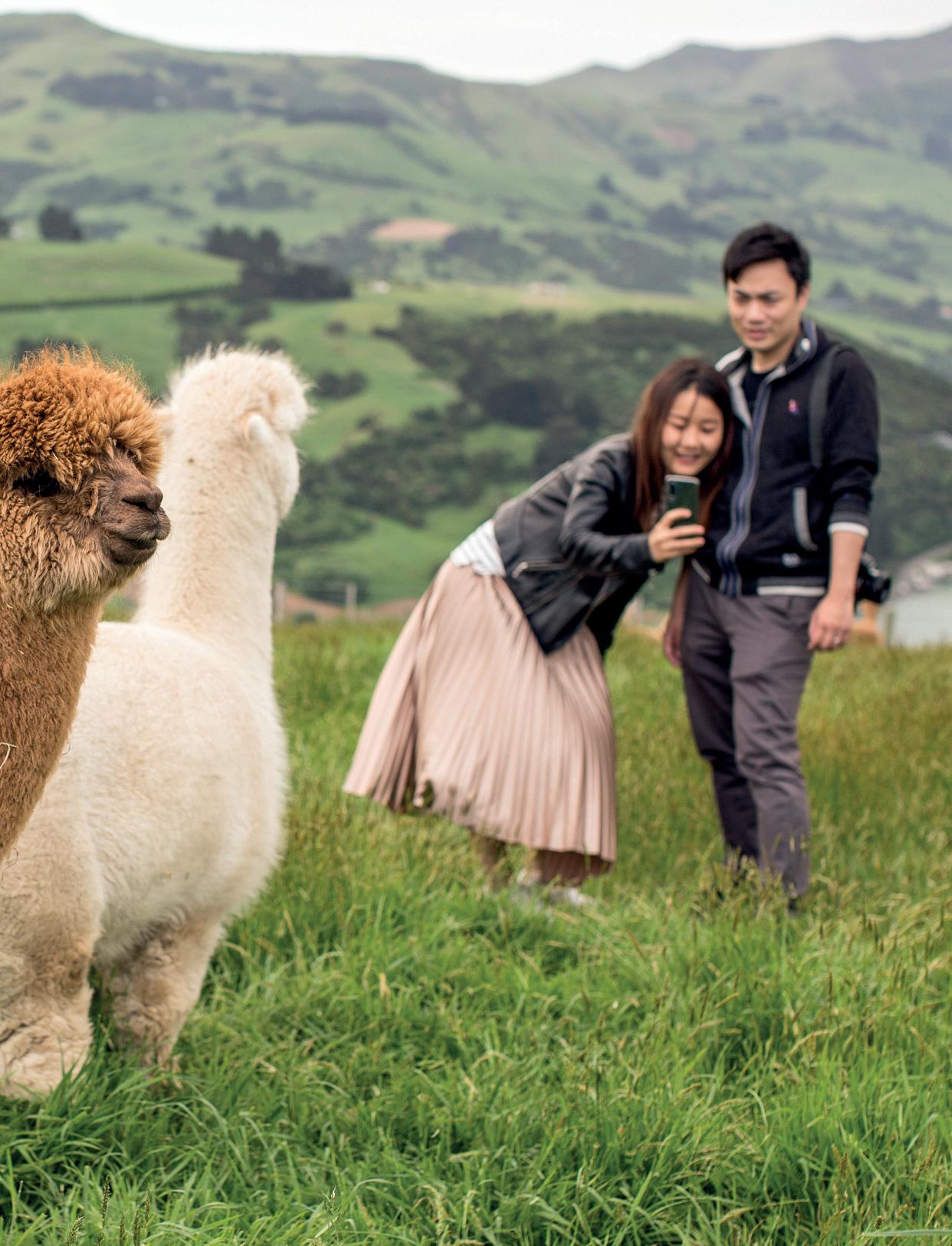
Alpacas in Akaroa have gone viral. Atop a hill with sea views, some of the most photographed alpacas reside.
Frank and Anya Walkington are self-confessed risk-takers, but even they didn’t expect their alpaca hobby would evolve into Shamarra Alpaca Farm – an ever-growing tourism, product and genetics business.

A love of the South American camelid is the backbone of the Walkington’s success but while their story has all the ingredients of a romance novel, it has been hard work.
Their feet are now firmly on New Zealand ground but like their stock, Frank and Anya originate from afar. Frank is originally from Zimbabwe and after travelling in Europe, he and a friend recognised an opportunity and built a 65-foot schooner which they sailed to the eastern Caribbean Island of Sint Maarten. There, they began a day charter island-hopping business.
Meanwhile Anya, who was born in South Africa, was sailing in the Caribbean with her parents and when they stopped off at Sint Maarten she met Frank.
The couple geared their Caribbean businesses to meet the high-end tourism market, which the island is known for, with a construction company, restaurants and retail.
They remained on the half-French, half-Dutch 34-square mile island for 20 years before deciding to shift to New Zealand to enable more opportunities for their children’s education.
In January 2003 they moved to a 24-acre block in Wainui, north of Auckland. They started with a few cattle, but their alpaca introduction at an A&P Show was love at first sight.
“We thought we would start small to see if we liked them and now 160 alpacas later, we think they are pretty good,” Anya says.
“We just fell in love with their personalities. They are very easy to love. The first one we bought was chosen because of its big beautiful eyes and beautiful caramel colours, it certainly was not a scientific decision.
“The first six years with alpacas was more of a hobby, although we did successfully show them at agricultural shows and had started marketing the genetics.”
Learning leads to quality focus
The pair immersed themselves in learning as much as they could through the New Zealand Alpaca Association, conferences, other breeders, research and experts.
“We realised early on it was all about genetics and producing a high-quality alpaca that provided a high-quality fleece,” Anya says.
“So we invested in top-quality alpacas to get the good genetics we wanted and that has been our philosophy the whole way through.”
The breeding side has grown so significantly that Shamarra now sell stud stock to clients in Europe, Australia and New Zealand.
Showing alpaca at A&P Shows and the annual national Alpaca show has been a great way to market the Shamarra genetics and promote the properties of alpaca.
Last year Shamarra Diesel won the national title at the New Zealand Alpaca Show, primarily in recognition of fleece quality.
When Auckland suburbia started moving too close, the couple decided they were ready for change and were keen to develop their alpaca business. They knew the drier South Island climate would be well suited to the alpaca and took the plunge, buying a 100-acre property at Akaroa – an hour from Christchurch.
The couple transported 60 alpacas to their new Banks Peninsula block, in an area known as French Farm, which overlooks the Akaroa Harbour and is a 20-minute drive from the main township.
“We were surrounded by sheep and beef farmers and I think they were wondering what this couple from Auckland was doing bringing 60 alpacas to Akaroa!” Anya recalls.
“We had three huge paddocks and no infrastructure, so the past nine years have been about building – starting with an access road and barn to provide shelter for the alpacas.
“At the beginning, we built a house which had a wing so we could provide luxury accommodation. However as the alpaca business grew, we concentrated on growing that aspect of the business.”
Known by name
The move south was one month before the 2011 Christchurch earthquakes, which while devastating, was the catalyst for the alpaca farm tours. With Lyttleton Harbour out of action, cruise ships started using the Akaroa Harbour and Peninsula locals suddenly had a captive tourist market on their doorstep.
Farm tours were a natural progression for the couple who had already been involved with cruise ships and the tourism industry in Sint Maarten.
“In the beginning it was hit and miss, we were available for tours when people turned up. Since then we have fine-tuned the business and developed the market. We now run four hour-long tours daily over seven days a week, peaking in the summer season, with visitors from cruise ships, groups and independent travellers.”
The Walkington’s traditionally saw summer as their busy season but they now have a steady stream of visitors in the winter.
“We run the business as professionally as possible. We are very aware of marketing and social media and have a very complementary relationship with Tourism New Zealand and Christchurch NZ,” Anya says.
“The Chinese market has been a growth area; Chinese people love alpacas – second only to panda bears! We hire four staff over the summer, including staff who are fluent in Mandarin, although we attract an enormous international spread of tourists.
“Our visitors love it – the beautiful location, the amazing harbour setting and view along with the drawcard of the famous alpacas makes it quite unique.
“The alpacas are full of attitude, are seriously cute and very photogenic. They are happy to be hugged, everyone wants a selfie with an alpaca. Their fleece feels amazing.
“Our alpacas are very comfortable with tourists. It is a handson interactive experience. The tours are in large paddocks, supervised by us or staff. Animal welfare is our priority, the alpacas all have different personalities, some are forward, some are aloof, and we respect that.”
Anya says they have a personalised approach which the visitors like. With alpacas being “very gentle animals”, the family has named all of them and know each of them individually.
“Visitors turn up asking to see an alpaca by name!”
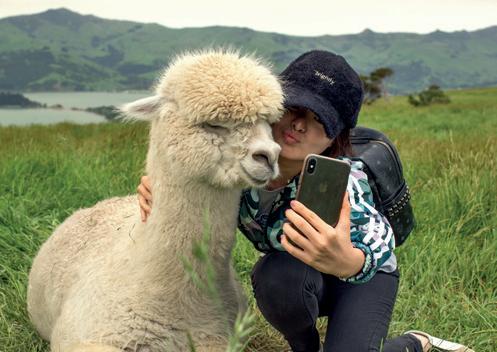
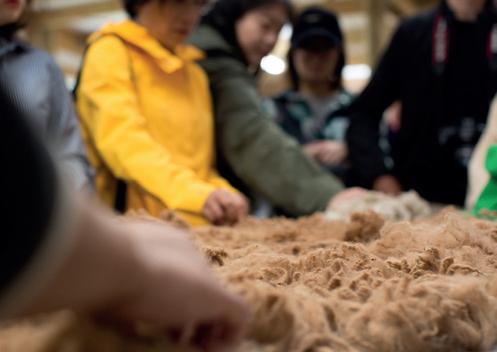
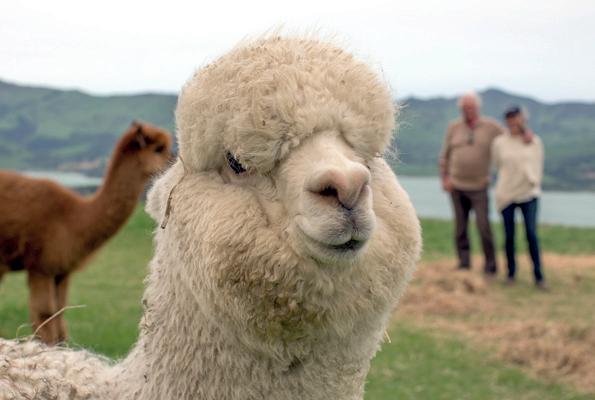
Products prove popular
Anya says ‘Rising Sun’ is her favourite.
“He is our game-changer, a breeding male we imported from Australia.”
The couple say the health of the herd is paramount. “Animal husbandry is very involved and our breeding is selective. Our focus is about a quality product across everything we do,” she says.
The birthing season is from December to March and the baby alpacas, cria, are exposed to tourists from just a few days old.
“We have scope to grow our herd size to 200, but we don’t want to compromise quality with quantity or lose our personal touch.
“Keeping it intimate is important for the alpacas too, they need their rest as well.”
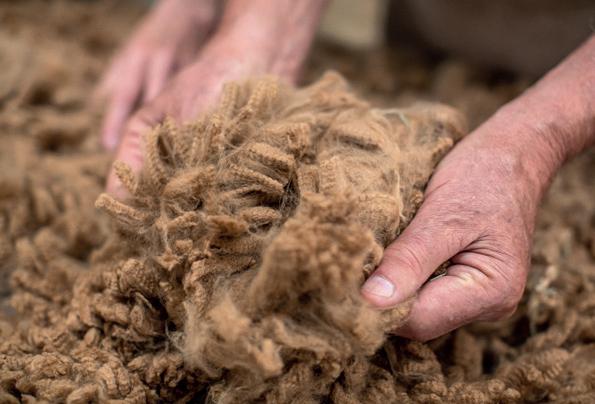
The Walkington’s high-end, New Zealand-made alpaca products use natural undyed fleece and are manufactured sustainably. The luxurious Shamarra alpaca knitwear is now a significant part of the business and an area they are growing from a digital platform.
Anya learned to knit as a young girl so had always had an attraction to fleece and fibre. She could see a future in the fleece and started developing a market.
“We now process four tonnes of alpaca fleece a year with the knitwear products designed and manufactured in New Zealand.”
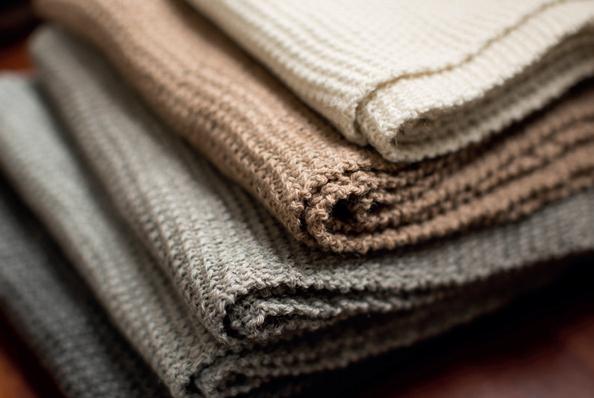
Yarn is produced from fleeces that have been individually micron tested with the high-quality Sovereign range featuring 16-18 micron and 24-26 micron for blankets and throws, all in the alpaca-rich natural colours.
“It is fraught with risk at every step and is an intricate supply chain process as we breed the animals, source the fleece and produce the products. Quality is the baseline in everything we do.”
The product range includes blankets, jerseys, beanies, scarves, ponchos and wraps sold from the farm shop and online.
The couple say there are moments when they sit back and pinch themselves and wonder how it has all happened.
They are pleased to have set up a succession plan with their daughter Alex keen to take on the operation while sons Eric, who is in the hospitality business and Ben, a pilot, will continue with their careers.
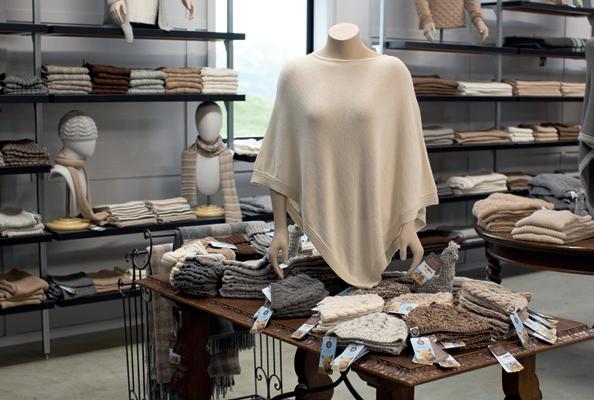
“We are passionate about alpacas, it’s not like we are going to work every day. In the Caribbean we tried to expand our businesses as much as we could but now we focus on quality and enjoying what we do,” Anya says.
History
Found high in the Andes Mountains of Peru the alpaca is a gentle, mystical creature with strong bonds to their human keepers.
Alpacas have provided fleece for thousands of years. The ancestors of the ancient Incan people wove fabric from the fleece of the alpaca that was so soft and so luxurious it was prized above all else and considered more valuable than gold. Alpaca fleece was known as ‘The fibre of the Gods’ and was reserved only for royalty.
The invasion of Peru by the Spanish Conquistadors in the mid-1500s led to the wholesale slaughter of the alpaca herds and their Incan keepers and to the destruction of the Incan empire.
The few ravaged alpaca herds that survived the slaughter were secretly moved to the barren and remote mountains of Peru.
It was not until the mid-1800s that alpaca was rediscovered. Since then they have slowly gained prominence and today are once again appreciated for their qualities and the natural beauty of their fleece.
For centuries it is the alpaca’s fleece that allowed the animals to defeat the chilling wind and freezing cold.
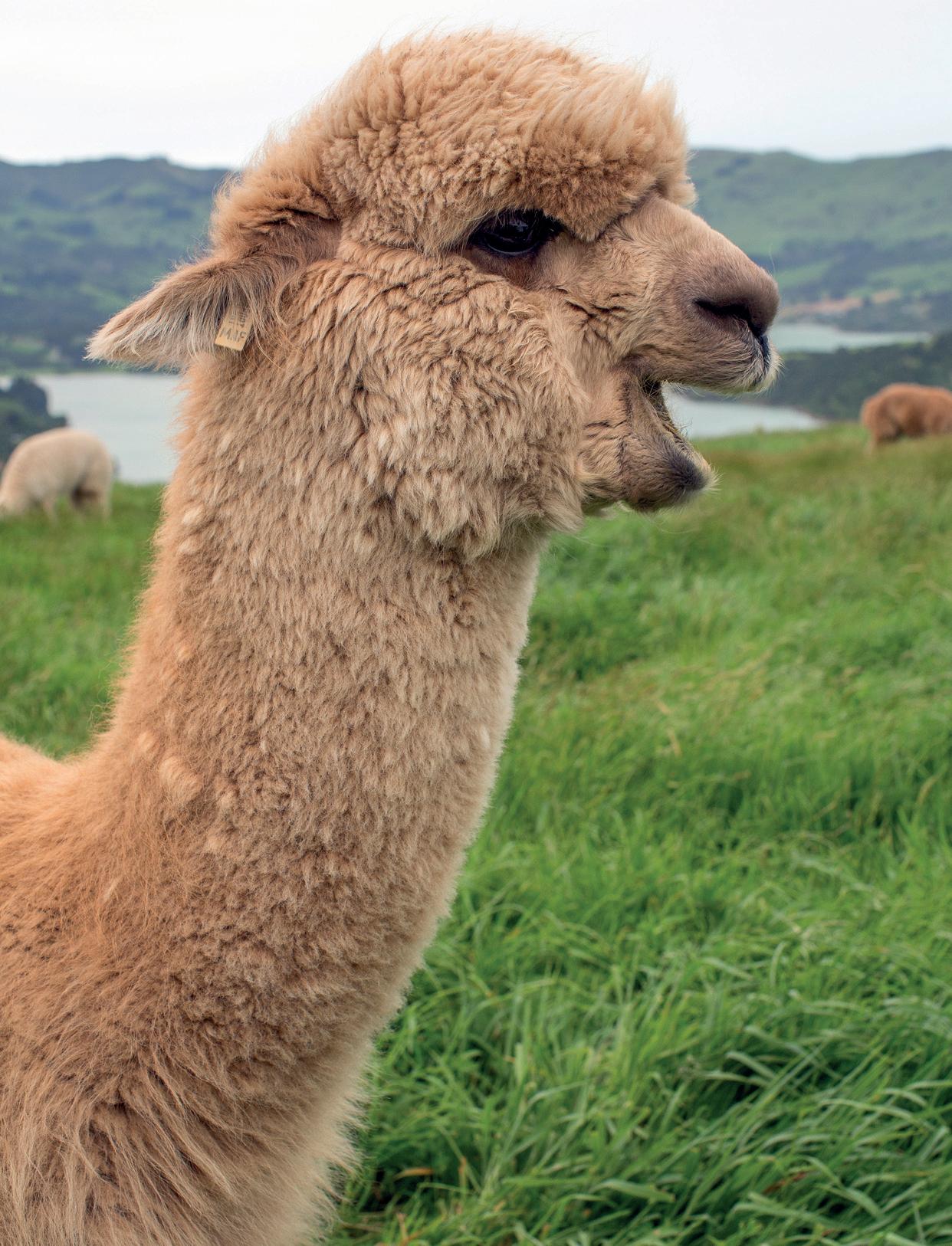
The natural fleece does not have to be dyed and grows in more than twenty rich, natural colours – from shades of dark charcoal to warm fawns and creamy whites.
Alpaca is the only animal in the world that produces such a large variety of natural colours. The fleece is sustainable, renewable and ecologically friendly. Alpacas can easily grow enough fibre to produce two or three jerseys in a year with an annual fleece growth of around 100mm.
Anya says all their Shamarra knitwear products are exclusive to them and celebrate the virtues of the fleece.
Alpacas have a minimal effect on the eco-system with their soft, padded feet gentle on the terrain.
There are a total population of four million alpaca worldwide with the alpaca female only producing one offspring each year. Twins are very rare.
The Walkington’s have based their knitwear business on the fact that today’s consumer demands high-quality, environmentally friendly and sustainable products made from naturally renewable resources.


